#atsuyaki tamago cheese
Text
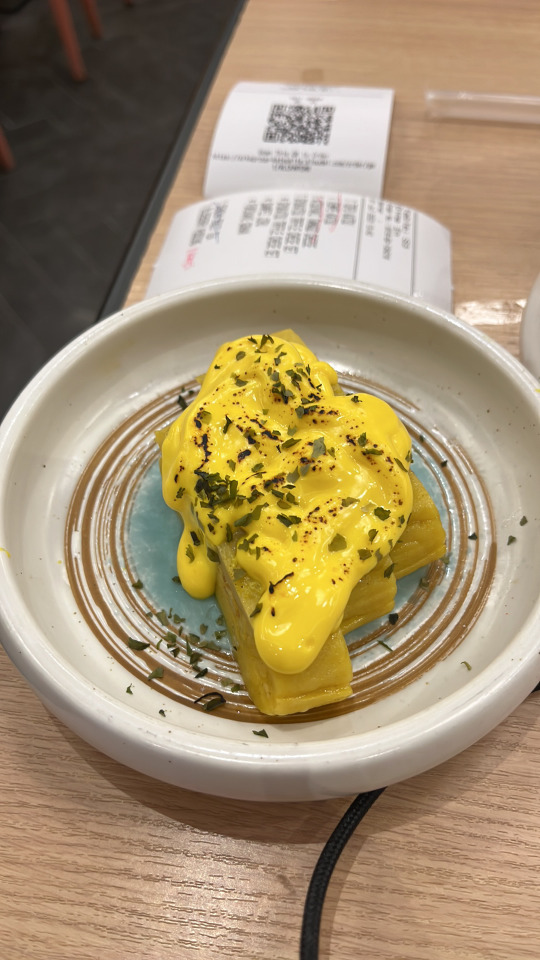

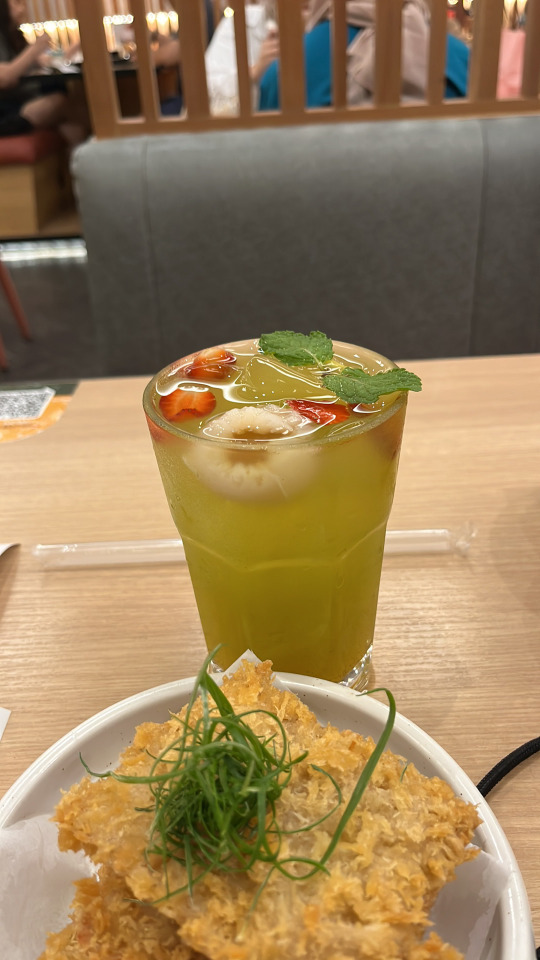
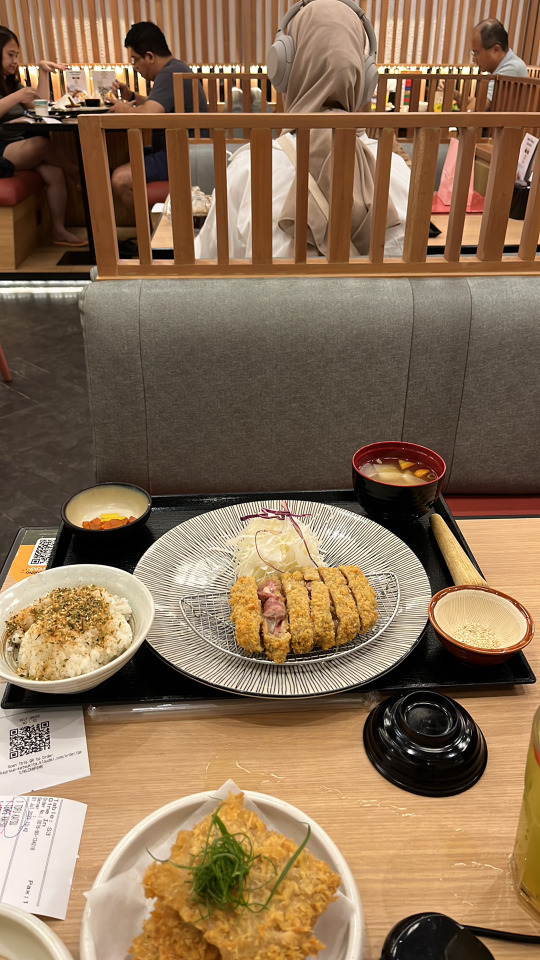



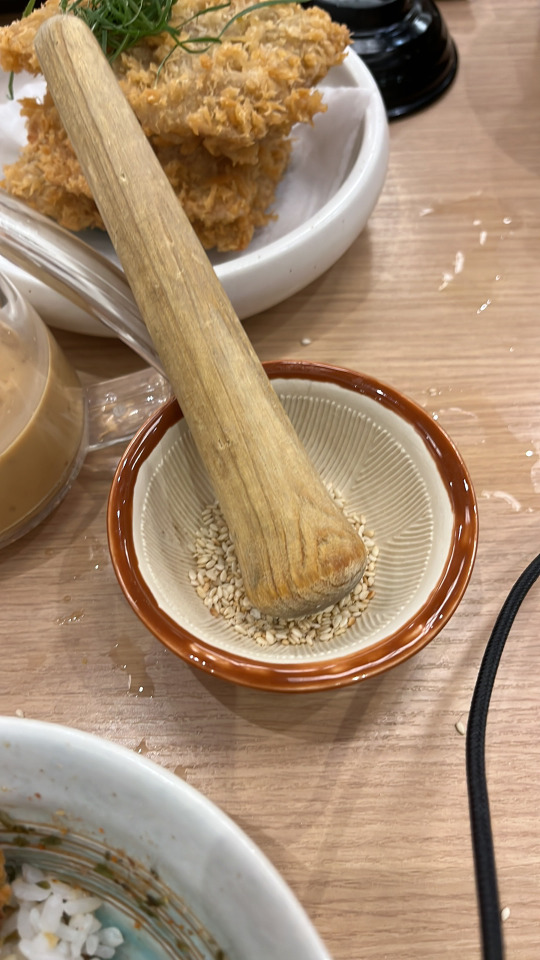
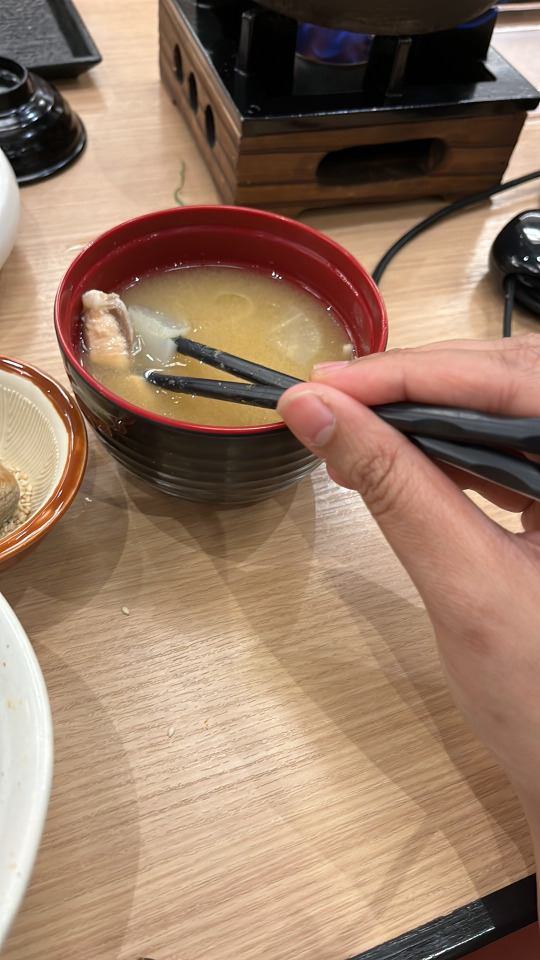

#atsuyaki tamago cheese#tempe katsu#sencha fruit tea#gyukatsu truffle cheese set#tofu katsu#furikake gohan#sanpei jiru#blueberry pudding
1 note
·
View note
Text
Tamagoyaki (Japanese Rolled Omelette) 玉子焼き
Sweet yet savory, Tamagoyaki (Japanese rolled omelette), makes a delightful Japanese breakfast or side dish for your bento lunches.
Tamagoyaki (卵焼き or 玉子焼き) is sweetened Japanese rolled omelette that resemble mini bars of golden pillows. With a slightly sweet taste and custardy texture, tamagoyaki is well loved amongst the Japanese children and adults alike. You’re most likely tasted the rolled eggs as part of a Japanese style breakfast or as a side dish in a bento (Japanese lunch box) or atop of sushi.
Because of the artful presentation, tamagoyaki does look deceivingly difficult to make. The technique involves some careful rolling of thin omelettes and folding into a layered log, which is then sliced. But it’s not an impossible task for home cooks like you and me. In fact, it is a staple in Japanese home cooking. We love the eggy goodness so much that we even invest in a special pan just for making tamagoyaki at home! My children adore tamagoyaki so I make it regularly for their bento box. Let me show you how today.
Watch How To Make Tamagoyaki 玉子焼きの作り方
youtube
Tamagoyaki is Japanese rolled omelette with dashi and soy sauce, enjoyed during Japanese breakfast or as a bento item.
What is Tamagoyaki?
In Japanese, tamago means eggs and yaki means grill. There are actually a few versions of rolled eggs in Japanese cuisine, which can be confusing. In general, you can find Atsuyaki tamago (厚焼き玉子) and Dashimaki tamago (だし巻き卵). Each variation uses slightly different ingredients, varying ratios of seasonings and cooking method, but sometimes the names are interchangeable.
When Japanese people say tamagoyaki, it typically refers to rolled egg or rolled omelette in a broad term. Atsuyaki Tamago (厚焼き玉子) refers to thick grilled egg, but we usually just call it Tamagoyaki. The texture of astuyaki tamago is firm and dense, and it’s much easier to make.
On the other hand, Dashimaki Tamago (出し巻き卵) refers to rolled egg which includes dashi (Japanese soup stock). In the Kanto region, dashimaki is also called the Tamagoyaki. However, in the Kansai region, these two rolled eggs are considered totally separate dishes. The main difference lies in the use of dashi, which resulting in a much more refined, juicy, silky, and flavorful rolled egg. At high-end sushi restaurants, they use an even higher amount of dashi and sugar and sometimes by mixing seafood into the egg mixture. You’d get a really flavorful and elegant egg dish which is served toward the end of a sushi course.
Compared to astuyaki tamago, dashimaki tamago is a lot softer due to the higher liquid content in the egg mixture. You can easily tell both versions of tamagoyaki apart by the textures and flavors, but both are delicious in their own way.
How is Tamagoyaki being made?
To make a basic tamagoyaki, you first beat the eggs just like you would with regular American-style omelette. Then season the whisked eggs with sugar, mirin, soy sauce, and a pinch of salt before pouring the egg mixture into a pan to cook. Once the bottom of the egg mixture is set, roll it up in multiple thin layers until the egg looks like a thick log. Finally, shape the egg and slice into thick pieces for serving.
The great thing about making Japanese rolled omelette at home is that you have the flexibility to experiment and be creative with the shapes. You can also add other ingredients such as seaweed, cheese, veggies and meat into tamagoyaki to change up the flavors.
The recipe that I am sharing today is dashimaki tamago because of the addition of dashi. It’s fluffy, moist and deeply flavorful. One bite you’d be very happy that you try it!
Helpful Tips on How to Make The Best Tamagoyaki at Home
Tamagokayi might require some practice to get right, but it’s something you will get better at each time you cook it. Here are a few helpful tips from me:
The ratio of dashi to eggs – When we add dashi into the egg mixture, it enhances the overall flavor and texture, but the liquid does make the cooking trickier. I used 3 tablespoons of dashi to make it easier for everyone to try. As a rule of thumb, 1 tablespoon of dashi per egg is a good ratio, but you can definitely add more once you’re better at it.
Do not worry about the first few rolls. The inner rolls do not need to be neat at all, as you will keep rolling more layers on top. The first few rolls are the center of the tamagoyaki, so even if the layers are not perfectly lined up, do not worry!
Do not skip oiling the pan. I know you want to use less oil. Me too! However, make sure you coat the pan with oil very well. You don’t want your egg mixture to stick to the pan – even for a non-stick pan.
Wait till the pan is completely heat up. Test the temperature of the pan with a small amount of the egg mixture. You need to see the egg sizzle to confirm the pan is hot enough.
Don’t turn off the heat; instead, move the pan away from the heat source. Keep your heat at medium at all times. Thin omelette layer needs to be quickly rolled up before it’s completely cooked, so there is no time for you to adjust the heat. The best way to control the heat is to move the pan closer and away from the stove.
It’s also important to find the right ratio of each seasoning, creating a balance between sweet and savory. If you like, adjust the amount of sugar and salt until it suits your taste.
Can I Make Tamagoyaki Without The Pan?
Many of my readers had asked if they can make tamagoyaki with a round pan.
My answer is yes. You don’t need a special tamagoyaki pan as long as you are not aiming for the classic shape. A tamagoyaki pan definitely helps to make the rolled omelette into a nice thick rectangular log; but a round frying pan will work just fine. You will see both methods demonstrated in my cooking video and the step-by-step pictures in the recipe below.
What Kind of Round Frying Pan Should I use for Tamagoyaki?
I recommend using 9 or 10-inch non-stick frying pan for a thicker tamagoyaki. In the recipe below, I used my 12-inch pan which works as well.
As you can see with the result, it will be flatter when your frying pan is bigger. If you only have a 12-inch pan, you can solve the issue by doubling the recipe. If you don’t mind the shape too much, then don’t worry about it.
Now, if you’re concerned about non-stick coating, you can use a cast iron skillet. However, please remember that you will need to control the amount of heat by lifting the pan from the stove and a heavy skillet would be challenging.
I’ve tried using a stainless steel frying pan for tamagoyaki, but without adding a bit of oil, I haven’t been successful. Since I don’t like my tamagoyaki too oily, I steer away from using stainless steel.
For most of my cooking, I refrain from using non-stick cookware, but it is easier to make with non-stick pan compared to stainless-steel or cast iron skillet.
If you don’t mind paying a little more for the pan, this copper tamagoyaki pan (nickel coating inside) is a great choice. The copper transfers heat so easily, and the pan is very light that you can move the pan easily while cooking.
Cut each piece of tamagoyaki diagonally to create “heart” shape.
Easy Tamagoyaki For Beginners
If you’re a beginner cook or prefer to take a short cut, you can try my Quick & Easy Tamagoyaki recipe which takes only 3 minutes to make! It’s perfect to make just one tamagoyaki for your meal or bento box.
I hope you enjoy making Tamagoyaki. If you try it, don’t forget to share your picture on Instagram, Facebook, or Twitter with #JustOneCookbook. I’d love to see your creations.
Hungry for More Tamago (Japanese Egg) Recipes?
Onsen Tamago (Japanese Hot Spring Eggs)
Hanjuku Tamago (Perfect Soft Boiled Eggs)
Tamago Tofu (Egg Tofu)
Tamago Sando (Japanese Egg Sandwich)
Ajitsuke Tamago (Ramen Egg)
Japanese Ingredient Substitution: If you want to look for substitutes for Japanese condiments and ingredients, click here.
Sign up for the free Just One Cookbook newsletter delivered to your inbox! And stay in touch with me on Facebook, Pinterest, YouTube, and Instagram for all the latest updates.
Tamagoyaki (Japanese Rolled Omelette)
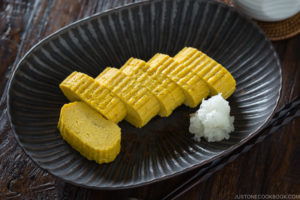
Sweet yet savory, Tamagoyaki (Japanese rolled omelette), makes a delightful Japanese breakfast or side dish for your bento lunches.
3 large eggs
2 Tbsp neutral flavor oil (vegetable, canola, etc)
1 ½ sheet nori (seaweed) ((optional; for omelette with nori in it))
Seasonings
3 Tbsp dashi ((Use Kombu Dashi for vegetarian))
2 tsp sugar
1 tsp soy sauce ((Use GF soy sauce for gluten-free))
1 tsp mirin
2 pinch salt (kosher or sea salt; use half if using table salt)
Garnish
1 inch daikon radish ((2.5 cm) (green part is sweeter than white part))
soy sauce ((Use GF soy sauce for gluten-free))
Gather all the ingredients.

Gently whisk the eggs in a bowl. It's best to "cut" the eggs with chopsticks in a zig-zag motion and do not over mix.

In another bowl, combine the seasonings and mix well.
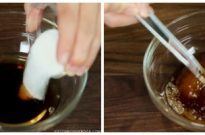
Pour the seasonings mixture into the egg mixture and whisk gently. Then pour the mixture into a measuring cup with spout and handle (so that it'll be easier to pour into the frying pan).

Tamagoyaki Pan Method
Heat the pan over medium heat, dip a folded paper towel in oil and apply to the pan. Put a little bit of egg mixture to see if the pan is hot.

When you hear the sizzling sound, pour a thin layer of egg mixture in the pan, tilting to cover the bottom of the pan.

Poke the air bubbles to release the air. After the bottom of the egg has set but still soft on top, start rolling into a log shape from one side to the other.

Move the rolled omelette to the side where you started to roll, and apply oil to the pan with a paper towel, even under the omelette.

Pour the egg mixture to cover the bottom of the pan again. Make sure to lift the omelette to spread the mixture underneath.
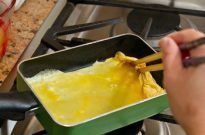
When the new layer of egg has set and still soft on top, start rolling from one side to the other.

Move the rolled omelette to the side where you started to roll, and apply oil to the pan with a paper towel, even under the omelette.

Pour the egg mixture to cover the bottom of the pan again. Make sure to lift the omelette to spread the mixture underneath.

When the new layer of egg has set and still soft on top, start rolling from one side to the other.

Now this is 3rd round. Poke the air bubbles…

The 4th round. Make sure to spread all over including under the rolled egg.

Continue rolling into the log.
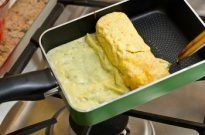
This is the 5th round.
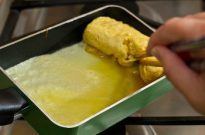
This is the 6th round and the final…

You can brown the omelette a little bit.

Remove from the pan and place the omelette on the bamboo mat and wrap it up. Shape the egg when it is still hot. Let it stand for 5 minutes.

Round Frying Pan Method
Heat the pan over medium heat, dip a folded paper towel in oil and apply to the pan. Put a little bit of egg mixture to see if the pan is hot. When you hear the sizzling sound, pour a thin layer of egg mixture in the pan, tilting to cover the bottom of the pan.

Poke the air bubbles to release the air. After the bottom of the egg has set but still soft on top, start rolling into a log shape from one side to the other. Here I put half sheet of nori and then rolled (optional).

Move the rolled omelette to the side where you started to roll, and apply oil to the pan with a paper towel, even under the omelette. Pour the egg mixture to cover the bottom of the pan again. Make sure to lift the omelette to spread the mixture underneath.

When the new layer of egg has set and still soft on top, start rolling from one side to the other. This is optional but I put another layer of nori sheet before rolling.

Move the rolled omelette to the side where you started to roll, and apply oil to the pan with a paper towel, even under the omelette. Then pour the egg mixture to cover the bottom of the pan again. Make sure to lift the omelette to spread the mixture underneath.
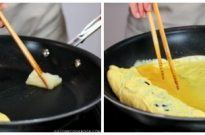
When the new layer of egg has set and still soft on top, start rolling from one side to the other. I put another sheet of nori here before rolling. Continue until all the egg mixture is finished.

Remove from the pan and place the omelette on the bamboo mat and wrap it up. Shape the egg when it is still hot. Let it stand for 5 minutes.
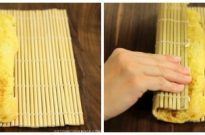
To serve
Slice the omelette into 1/2″ (1 cm) pieces.

Peel and grate daikon. Gently squeeze water out. Serve Tamagoyaki with grated daikon and pour soy sauce over daikon.

To Keep
You can put tamagoyaki in an airtight container and store in the freezer for up to 2 weeks. Defrost overnight in the refrigerator or microwave.
Control the temperature of the pan by lifting the frying pan rather than adjusting the stove heat. If the heat is too weak, the egg will stick to the frying pan so be careful.
Equipment you will need:
Tamagoyaki frying pan (or a around 9″ or 10″ non-stick frying pan)
Long cooking chopsticks
Bamboo sushi mat
Recipe by Namiko Chen of Just One Cookbook. All images and content on this site are copyright protected. Please do not use my images without my permission. If you’d like to share this recipe on your site, please re-write the recipe and link to this post as the original source. Thank you.
Editor’s Note: This post was originally published in March 2012. The video and new photos were added in January 2016. The post content was updated in August 2019.
Tamagoyaki (Japanese Rolled Omelette) 玉子焼き published first on https://zenramensushi.tumblr.com/
0 notes